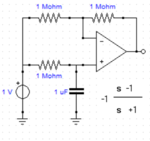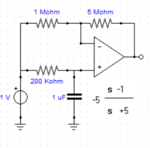
- Joined
- Jan 22, 2008
- Messages
- 53,659
- Helped
- 14,809
- Reputation
- 29,911
- Reaction score
- 14,422
- Trophy points
- 1,393
- Location
- Bochum, Germany
- Activity points
- 303,418
OK thanks. Just for information, how is a LHPZ + single pole combo of unequal pole/zero frequency realized pls?
See comparison of standard all-pass and unequal (lhp)pole/zero circuits


Not possible with simple discrete circuit. Applies either to digital signal processing or switched capacitor circuit.And just in case I needed to implement the TF in 'z' domain, how could I do so?
Any general purpose OP.Which discrete op amp IC would you suggest for physical realization of the TF? Though there are many op amps available, which one would be adept in the job?
Still not sure what's your application for the transfer function, what are the involved signals and respectively what kind of test is useful.Finally during testing, what characteristics does one need to check for a filter? I know mainly about 3 dB frequency and that the roll down/up rate to be 20dB

